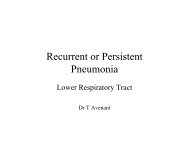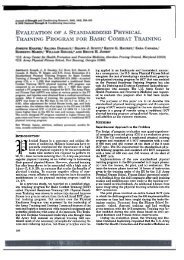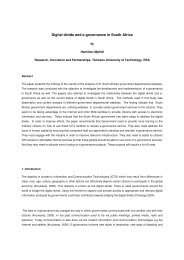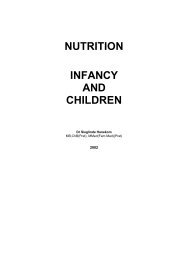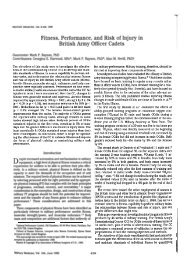Research and Training Strategies for Goat Production Systems in ...
Research and Training Strategies for Goat Production Systems in ...
Research and Training Strategies for Goat Production Systems in ...
You also want an ePaper? Increase the reach of your titles
YUMPU automatically turns print PDFs into web optimized ePapers that Google loves.
secondary cities <strong>and</strong> 35% <strong>in</strong> small towns (Rogerson, 1998). This is partially due to high<br />
levels of unemployment <strong>in</strong> these areas: metropolitan areas: 21%, secondary cities: 27%,<br />
small towns: 28%. Of particular concern are the unemployment statistics <strong>for</strong> the<br />
economically important 15-24 year old age group: metropolitan areas: 36% (males) <strong>and</strong> 43%<br />
(females); secondary cities: 48% (males) <strong>and</strong> 59% (females); small towns: 47% (males) <strong>and</strong><br />
54% (females). As these communities are free of the labour <strong>and</strong> l<strong>and</strong> tenure constra<strong>in</strong>ts<br />
which apply to rural communal areas, the issues of unemployment <strong>and</strong> poverty may<br />
represent opportunities <strong>for</strong> research aimed at establish<strong>in</strong>g <strong>and</strong> improv<strong>in</strong>g small-farmer<br />
animal production enterprises. Small farmer systems have been established elsewhere <strong>in</strong> the<br />
world with much success (notably so <strong>in</strong> Kenya) <strong>and</strong> represent a range of opportunities <strong>for</strong><br />
the animal scientist. There is no reason why the products of >high-tech= research developed<br />
<strong>for</strong> <strong>in</strong>tensive <strong>and</strong> first-world farm<strong>in</strong>g systems should not be implemented <strong>in</strong> small-farmer<br />
systems; <strong>in</strong> fact the implementation of technologies such as artificial <strong>in</strong>sem<strong>in</strong>ation, hormone<br />
adm<strong>in</strong>istration <strong>and</strong> specialised nutrient supplementation would be far easier <strong>in</strong> the case of the<br />
small-farmer with 6 stall-fed cows than <strong>in</strong> the case of the <strong>in</strong>tensive commercial farmer with<br />
600 cows at pasture. Similarly, it is not hard to envisage that future technologies such as the<br />
strategic adm<strong>in</strong>istration of compounds which regulate gene expression at particular<br />
physiological stages would be safer <strong>and</strong> easier to apply <strong>in</strong> a small-farmer system than <strong>in</strong> any<br />
other system.<br />
Conclusions<br />
In conclusion, it is proposed that the lack of any real improvement <strong>in</strong> the efficiency of<br />
animal production <strong>in</strong> communal areas (despite many research projects) <strong>in</strong>dicates that the real<br />
issue to be addressed <strong>in</strong> this situation relates more to research directed at the sociology of<br />
l<strong>and</strong> tenure systems than to animal science research. In an assessment of animal agriculture<br />
<strong>in</strong> Sub-Saharan Africa, it was concluded that Α<strong>Strategies</strong> <strong>for</strong> pastoral systems should focus<br />
on the acquisition of l<strong>and</strong> use rights <strong>for</strong> grazers <strong>and</strong> the establishment of locally managed<br />
<strong>and</strong> controlled l<strong>and</strong> <strong>and</strong> water management systems (W<strong>in</strong>rock International, 1992). In<br />
contrast, the latter report states that Αmost of the successful projects have been mixed croplivestock<br />
projects such as smallholder dairy development (Kenya) ... <strong>and</strong> smallholder<br />
systems of fatten<strong>in</strong>g (Cameroon, Nigeria, <strong>and</strong> Senegal)≅. It is proposed that the real issue <strong>for</strong><br />
prioritisation of animal science <strong>and</strong> goat research <strong>in</strong> South Africa relates to small-farmer<br />
enterprises among the urban poor.<br />
References:<br />
Etherton, T. D., 1998. Emerg<strong>in</strong>g strategies <strong>for</strong> enhanc<strong>in</strong>g growth - is there a biotechnology<br />
better than growth promotants? Biotechnologie, agronomie societe et environment, (special<br />
issue), pp 16.<br />
Mahanjana, A.M., 1999. Factors affect<strong>in</strong>g goat production <strong>in</strong> a communal farm<strong>in</strong>g system.<br />
M.Inst.Agrar. Dissertation, University of Pretoria.<br />
Nieuwoudt, W.L., 1998. The dem<strong>and</strong> <strong>for</strong> prote<strong>in</strong> feed <strong>in</strong> South Africa <strong>for</strong> 2000, 2010 <strong>and</strong><br />
2020: Part II. Agrecon, 37: 143-159.<br />
Rogerson, C.M., 1998. Urban agriculture <strong>and</strong> urban poverty alleviation: South African<br />
debates. Agrecon, 37: 171-183.<br />
4








